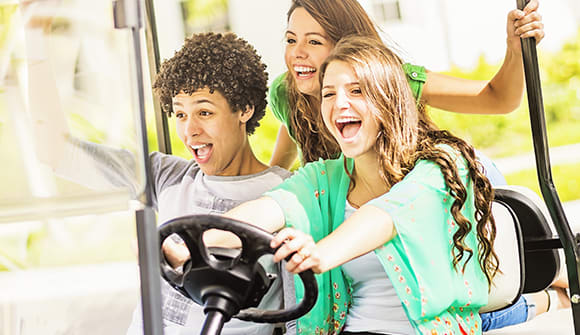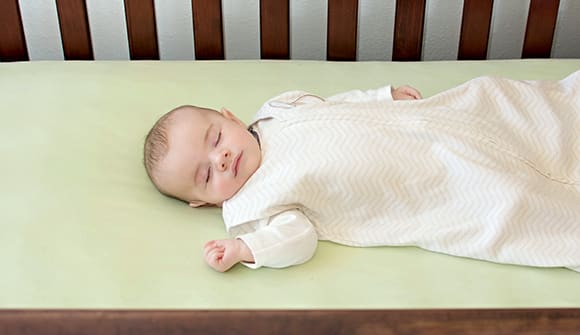Not all fun and games
Golf cart-related injuries in kids are more common than you may think.
Article Author: Tina Smithers Peckham
Article Date:

Despite their name, golf carts are more than merely a means of transportation in between holes on the green. These beloved caddy carriers are being used more and more as a way to get around town – especially throughout the Beaches, St. Johns County and Clay County communities. But alongside their increase in popularity comes a rise in serious golf cart-related injuries, especially in children.
Lisa Nichols, RN, manager of the Porter Family Children's Trauma Center at Wolfson Children’s Hospital, confirms there has been a dramatic increase in golf cart-related trauma in recent years.
“The Wolfson Children’s Trauma team is trained to provide specialized care to the most critically injured babies, children and teens in Northeast Florida and far beyond,” she said, adding, “Sadly, our Pediatric Trauma Center has seen an over 300% increase in golf cart crashes and injuries over the past three years.”
Nichols, who is also the president of the Pediatric Trauma Society, credits the golf cart surge with the influx of communities where this alternate mode of transportation is becoming more and more acceptable, as well as the many misconceptions that arise: Namely that golf carts are “easy” and “safe” to use. But the truth is, a golf cart isn’t the same as a car, and the reasoning for the resulting injuries is twofold: Many folks aren’t aware of the laws and safety regulations surrounding golf cart usage, and these laws aren’t always enforced.
Hidden dangers (and how to avoid them)
One recent nationwide study found more than 6,500 children are injured each year while driving or riding in golf carts, with more than half of them aged 12 and under. While data confirms the Wolfson Children’s Trauma Center has seen a steady increase in golf cart injuries, they only have data on the most critically injured children who are admitted to the hospital.
Nichols said the most common golf cart-related injuries in children include concussions, skull fractures or more severe traumatic brain injuries (i.e., bleeding in the brain). Other injuries include broken arms and legs, rib and spinal fractures, lung contusions, and liver and spleen lacerations, as well as bruising and significant cases of “road rash.”
The good news is that many of these injuries can be avoided. Nichols said to utilize golf carts as they were intended – to be driven on the sidewalk, grass or designated golf cart paths, not on the road, and especially with no one “hanging off” or riding while standing on the back.
“Many golf carts now come with seat belts,” she said. “Riders should be belted in appropriately, and there should be a seat belt – or at least a proper seat, if there are no seat belts – for every person on the golf cart. And if a car seat is used, it should be belted into the golf cart, just as it would be in a car.”
Back to (golf cart safety) basics
You should always read the owner’s manual thoroughly for important safety information and check the driver’s license requirements in your state. Here are a few additional safety tips regarding the use of golf carts in your neighborhood or community:
- Only transport the number of passengers you have seats or seat belts for, and operate the cart from the driver’s seat ONLY.
- Fully engage the parking brake and remove the key before exiting the vehicle.
- Obey and follow all traffic rules, including wearing your seat belt.
- Keep feet, legs, hands and arms inside the vehicle at all times.
- Ensure the direction selector is in the correct position before accelerating and always bring the vehicle to a complete stop before shifting direction.
- Slow down before and during turns, as well as when driving downhill.
- Check behind you before going in reverse.
- Always yield to pedestrians.
- Don’t drive while texting, intoxicated or during a lightning storm.
- Don’t allow anyone to stand up while the golf cart is moving.
- Use extra caution when driving in bad weather conditions or on poor surfaces.
- Avoid rough terrain and steep slopes.
- Be aware that sudden stops or changes of direction could make you lose control of the golf cart.
If your child needs emergency treatment, Wolfson Children’s Hospital has physicians specially trained in pediatric emergency care ready to help 24/7. The Porter Family Children's Trauma and Emergency Center at Wolfson Children’s Hospital is the only state-designated Pediatric Trauma Center in the area and the only American College of Surgeons-verified Level 1 Pediatric Trauma Center in the region, caring for the area’s most critically ill and injured children. Wolfson Children’s Hospital has Emergency Centers located throughout Northeast Florida.
Sources: American Academy of Pediatrics, Florida Highway Safety and Motor Vehicles



